the history of yeovil's pubs
PUBS HOME PAGE |
PUBS INTRODUCTION |
PUBS BY NAME |
BEERHOUSES |
elephant & castle inn / hotel
59 Middle Street / 125 Middle Street
The Elephant and Castle Hotel (marked 'D' on the map below) was a purpose-built public house / hotel that opened in 1860 on the corner of Lower Middle Street and Wyndham Street.
For interest - the original name "Elephant and Castle" is derived from a London coaching inn and the earliest surviving record of this name relating to the area appears in the Court Leet Book of the Manor of Walworth, which met at "Elephant and Castle, Newington" on 21 March 1765. Previously the site was occupied by a blacksmith and cutler – the coat of arms of the Worshipful Company of Cutlers features an elephant with a castle (most likely meant to be a howdah) on its back, which in turn was used because of the use of elephant ivory in knife handles. The folk etymology stating that "Elephant and Castle" is a corruption of "La Infanta de Castilla" - allegedly a reference to a series of Spanish princesses such as Eleanor of Castile - is, however, completely incorrect.
Yeovil's Elephant and Castle building is of three storeys, built in rendered brickwork under a Welsh slate roof. Wide string courses and wide, flat pilasters break the elevation into a visual grid pattern. All the windows have stone surrounds with corbelled cills, the windows to the ground floor only having arched heads. Two side doors, facing Middle Street have similar arched heads while the main entrance on the corner is surprisingly plain. Over the corner entrance the first floor has French doors opening onto an intricate wrought iron balcony. From the advertisement below, from the 27 January 1882 edition of the Western Gazette, it is seen that the inn contained a bar, smoking room, coffee and commercial rooms, ten bedrooms, good kitchens and offices.
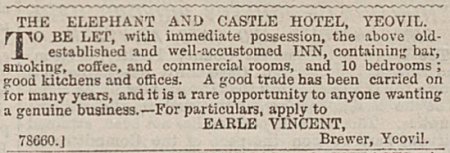
Western Gazette,
27 January 1882
At the end of the building a low archway, or porte-cochere, with decorative stone surround and double doors gives the impression that it leads to stabling, which it may have done in the past, however because the Elephant and Castle occupies a corner plot the rear is wedge-shaped and very tiny so any stabling would have, by necessity, been to the side of the building.
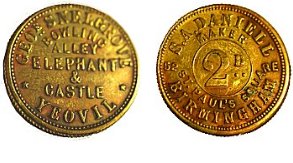 At
left is a public
house 'check' or
trade token
issued at the
Elephant and
Castle Hotel
during the
period George
Snelgrove was
licensee -
roughly between
1871 and 1881.
It is made of
brass. The check is 23.7mm
in diameter and
with a milled
edge. On the
obverse it says
"GEOE. SNELGROVE
- BOWLING ALLEY
- ELEPHANT &
CASTLE - YEOVIL"
and on the
reverse is the
maker's name
"S.A. DANIELL
MAKER - 52 ST
PAUL'S SQUARE -
BIRMINGHAM" and
the check's
value - 2D. At
this time two
old pence could
buy you a pint
of stout. Checks
were frequently
used in games,
such as skittles
or quoits where,
for instance,
players would
'chip in' a
check to the
'kitty' which
would be won by
the winning team
to redeem at the
bar. By issuing
checks a
landlord could
guarantee they
would be spent
in his
establishment
only.
At
left is a public
house 'check' or
trade token
issued at the
Elephant and
Castle Hotel
during the
period George
Snelgrove was
licensee -
roughly between
1871 and 1881.
It is made of
brass. The check is 23.7mm
in diameter and
with a milled
edge. On the
obverse it says
"GEOE. SNELGROVE
- BOWLING ALLEY
- ELEPHANT &
CASTLE - YEOVIL"
and on the
reverse is the
maker's name
"S.A. DANIELL
MAKER - 52 ST
PAUL'S SQUARE -
BIRMINGHAM" and
the check's
value - 2D. At
this time two
old pence could
buy you a pint
of stout. Checks
were frequently
used in games,
such as skittles
or quoits where,
for instance,
players would
'chip in' a
check to the
'kitty' which
would be won by
the winning team
to redeem at the
bar. By issuing
checks a
landlord could
guarantee they
would be spent
in his
establishment
only.
By the 1890s the Elephant and Castle was a tied house of the Royal Osborne Brewery, owned by Earle Vincent. When Vincent died in 1893 his estate was sold off the following year which included "the Elephant and Castle Hotel, let at £50 a year (about £5,000 at today's value)."
In the Yeovil Guide of 1962 the Manor Hotel and the Mermaid Hotel were the most expensive hotels in Yeovil with Bed and Breakfast from 25/- per night (about £48 at today's value). For comparison the Three Choughs Hotel was 22/6 per night, the Pen Mill Hotel was 16/-, the Elephant & Castle Hotel was 15/6 and the Globe & Crown was cheapest at 14/6 (about £13.50 at today's value). By 1970 the prices were still the most expensive at the Manor Hotel with Bed & Breakfast from 45/- to 55/- per night (£50 to £63 at today's value), lunch at 14/6 (about £19) and dinner at 16/6 (about £22). Again for comparison, Bed & Breakfast at the Three Choughs Hotel was 42/- per night with breakfast only at 9/6 and tea from 3/6, the Preston Hotel was from 32/6 per night with lunch at 12/6 and dinner from 14/6, the Butchers Arms was 25/- for a single and 45/- for a double room per night and the Elephant & Castle Hotel was cheapest at 21/6 (about £29) per night.
![]()
The first licensee was Job Osment who was born on 26 August 1821 at Nether Cerne, Dorset. In the 1841 census while living in Dorchester, Dorset, he was listed as a male servant and it was in Dorchester that he met Sophia Stoodley and they married in Poole, Dorset, on 20 December 1845. By the time of the 1851 census Job and Sophia had moved to Yeovil and Job was listed as a licensed victualler running the Greyhound in South Street and he was also listed there in Slater's Directory of 1852. When the Elephant and Castle opened in 1860, Job was its first licensee and he is listed as such in the 1861 census with Sophia. Sadly, on 2 April 1862, at the age of 40, Job committed suicide by leaping from a window of the Elephant and Castle. The following newspaper extract tells the story -
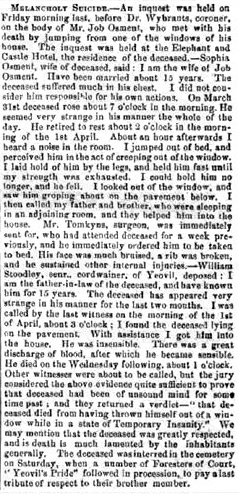 MELANCHOLY
SUICIDE - An
inquest was held
on Friday
morning last,
before Dr
Wybrants,
coroner, on the
body of Mr Job
Osment, who met
with his death
by jumping from
one of the
windows of his
house. The
inquest was held
at the Elephant
and Castle
Hotel, the
residence of the
deceased. Sophia
Osment, wife of
the deceased,
said: I am the
wife of Job
Osment. Have
been married
about 15 years.
The deceased
suffered much in
his chest. I did
not consider him
responsible for
his own actions.
On March 31st
deceased rose
about 7 o'clock
in the morning.
He seemed very
strange in his
manner the whole
of the day. He
retired to rest
about 2 o'clock
in the morning
of the 1st
April. About an
hour afterwards
I heard a noise
in the room. I
jumped out of
bed and
perceived him in
the act of
creeping out of
the window. I
laid hold of him
by the legs, and
held him fast
until my
strength was
exhausted. I
could hold him
no longer and he
fell. I looked
out of the
window, and saw
him groping
about on the
pavement below.
I then called my
father and
brother, who
were sleeping in
an adjoining
room, and they
helped him into
the house. Mr
Tomkyns,
surgeon, was
immediately sent
for, who had
attended
deceased for a
week previously,
and he
immediately
ordered him to
be taken to bed.
His face was
much bruised, a
rib was broken,
and he sustained
other internal
injuries.
William Stoodley,
senr.,
cordwainer of
Yeovil, deposed:
I am the
father-in-law of
the deceased,
and have known
him for 15
years. The
deceased has
appeared very
strange in his
manner for the
past two months.
I was called by
the last witness
on the morning
of the 1st of
April, about 3
o'clock: I found
the deceased
lying on the
pavement. With
assistance I got
him into the
house. He was
insensible.
There was a
great discharge
of blood, after
which he became
sensible. He
died on the
Wednesday
following, about
1 o'clock. Other
witnesses were
about to be
called, but the
jury considered
the above
evidence quite
sufficient to
prove that
deceased had
been of unsound
mind for some
time past, and
they returned a
verdict - "that
deceased died
from having
thrown himself
out of a window
while in a state
of Temporary
Insanity." We
may mention that
the deceased was
greatly
respected, and
his death is
much lamented by
the inhabitants
generally. The
deceased was
interred in the
cemetery on
Saturday, when a
number of
Foresters of
Court, "Yeovil's
Pride" followed
in procession,
to pay a last
tribute of
respect to their
brother member."
MELANCHOLY
SUICIDE - An
inquest was held
on Friday
morning last,
before Dr
Wybrants,
coroner, on the
body of Mr Job
Osment, who met
with his death
by jumping from
one of the
windows of his
house. The
inquest was held
at the Elephant
and Castle
Hotel, the
residence of the
deceased. Sophia
Osment, wife of
the deceased,
said: I am the
wife of Job
Osment. Have
been married
about 15 years.
The deceased
suffered much in
his chest. I did
not consider him
responsible for
his own actions.
On March 31st
deceased rose
about 7 o'clock
in the morning.
He seemed very
strange in his
manner the whole
of the day. He
retired to rest
about 2 o'clock
in the morning
of the 1st
April. About an
hour afterwards
I heard a noise
in the room. I
jumped out of
bed and
perceived him in
the act of
creeping out of
the window. I
laid hold of him
by the legs, and
held him fast
until my
strength was
exhausted. I
could hold him
no longer and he
fell. I looked
out of the
window, and saw
him groping
about on the
pavement below.
I then called my
father and
brother, who
were sleeping in
an adjoining
room, and they
helped him into
the house. Mr
Tomkyns,
surgeon, was
immediately sent
for, who had
attended
deceased for a
week previously,
and he
immediately
ordered him to
be taken to bed.
His face was
much bruised, a
rib was broken,
and he sustained
other internal
injuries.
William Stoodley,
senr.,
cordwainer of
Yeovil, deposed:
I am the
father-in-law of
the deceased,
and have known
him for 15
years. The
deceased has
appeared very
strange in his
manner for the
past two months.
I was called by
the last witness
on the morning
of the 1st of
April, about 3
o'clock: I found
the deceased
lying on the
pavement. With
assistance I got
him into the
house. He was
insensible.
There was a
great discharge
of blood, after
which he became
sensible. He
died on the
Wednesday
following, about
1 o'clock. Other
witnesses were
about to be
called, but the
jury considered
the above
evidence quite
sufficient to
prove that
deceased had
been of unsound
mind for some
time past, and
they returned a
verdict - "that
deceased died
from having
thrown himself
out of a window
while in a state
of Temporary
Insanity." We
may mention that
the deceased was
greatly
respected, and
his death is
much lamented by
the inhabitants
generally. The
deceased was
interred in the
cemetery on
Saturday, when a
number of
Foresters of
Court, "Yeovil's
Pride" followed
in procession,
to pay a last
tribute of
respect to their
brother member."
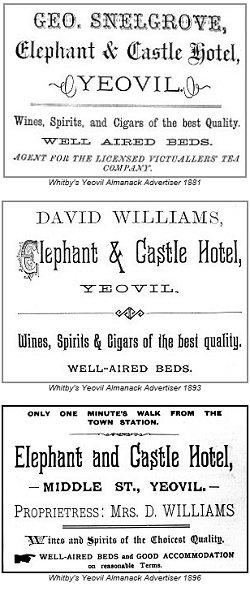 The next
licensee was
George Snelgrove
who was born
around 1833 in
Frome, Somerset,
the son of Mary
Snelgrove. By
the time of the
1871 census
George was
listed as inn
keeper at the
Elephant and
Castle with his
Cheshire-born
wife, Mary.
According to
Whitby's Yeovil
Almanack
Advertiser of
1878 George was
also an Agent
for the Licensed
Victuallers' Tea
Company. George
and Mary
appeared again
in the 1881
census by which
time his mother,
Mary, was living
with them.
The next
licensee was
George Snelgrove
who was born
around 1833 in
Frome, Somerset,
the son of Mary
Snelgrove. By
the time of the
1871 census
George was
listed as inn
keeper at the
Elephant and
Castle with his
Cheshire-born
wife, Mary.
According to
Whitby's Yeovil
Almanack
Advertiser of
1878 George was
also an Agent
for the Licensed
Victuallers' Tea
Company. George
and Mary
appeared again
in the 1881
census by which
time his mother,
Mary, was living
with them.
George Snelgrove was followed by the Williams family who also appear to have had something of a tragic tenancy - in 1889 James is recorded as licensee to be succeeded within a couple of years by his son David by 1891. David was to die in 1895 and the license was taken over by his widow for just a year.
William Garlick was born in September 1867 in Yeovil, the son of Wiltshire-born leather dresser Tom Garlick and his Yeovil-born glove sewer wife, Mary Ann, née Mullins. In the 1871 census the young family is listed living in Victoria Buildings, a small group of houses at the bottom of Addlewell Lane built specifically to house workers in the gloving industry. Tom and Mary had married in 1866 but sadly Tom died in June 1871. Mary remarried and in the 1881 census was still living in Victoria Buildings, but with her new husband, Albert Fowler and his two children, while William was listed as Albert's stepson. William married in July 1893 and by 1901 was living in Earle Street with his wife, Eva. William was listed as a foreman glover and Eva was a glove machinist. By 1905, according to the dated photo below, William was the licensee of the Elephant and Castle where he was to remain until his death in 1923.
Following William were only a few licensees and the longest-serving was Ernest Turvey who was licensee from 1939 until the mid-1950's. It is nice to see that all the licensees felt it necessary to highlight their 'well aired beds' in the advertisements at left.
The Elephant and Castle closed in 1977 and is now offices.
map
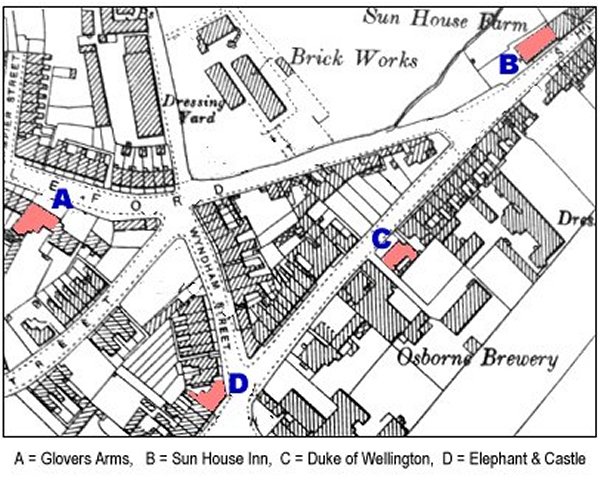
Sketch Plan of the Elephant & Castle Inn / Hotel
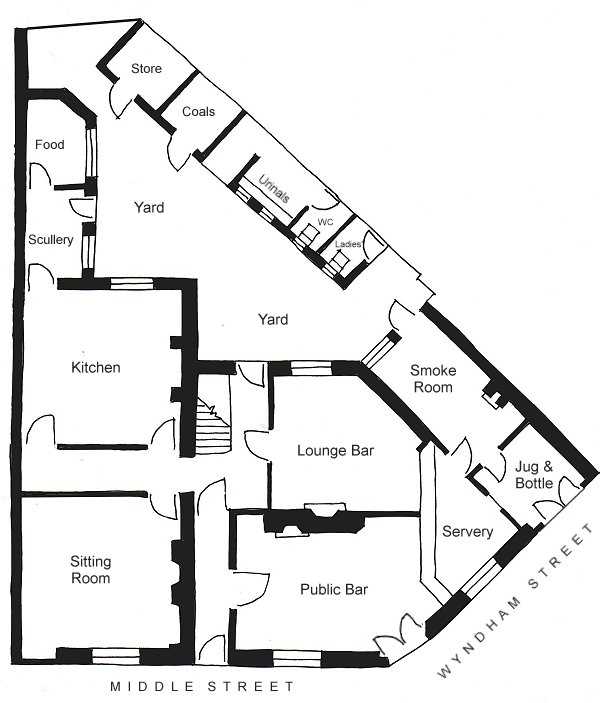
This is a sketch based on plans held at the Heritage Centre, Taunton. The original plans are dated 1970, when Bass Charrington (SW) Ltd were the owners. The scullery, various stores and toilets were all single storey lean-to buildings. The first floor of the main building had a large lounge for hotel guests on the corner over the public bar and servery, three bedrooms, a bathroom and a separate WC, while the second floor had four bedrooms, a bathroom and a separate WC. The sitting room would most likely have doubled as a dining room for hotel guests.
gallery
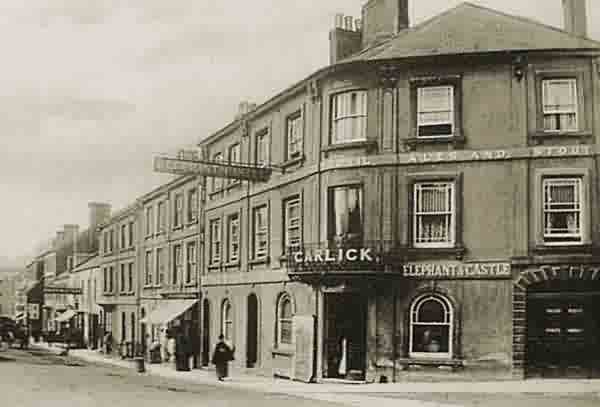
This photograph
features in my
books 'Yeovil From Old Photographs'
and "Yeovil
In 50 Buildings"
Photographed in 1905, during the period William Garlick was licensee, this view of the Elephant and Castle Hotel includes many neighbouring buildings in Middle Street that remain to this day.
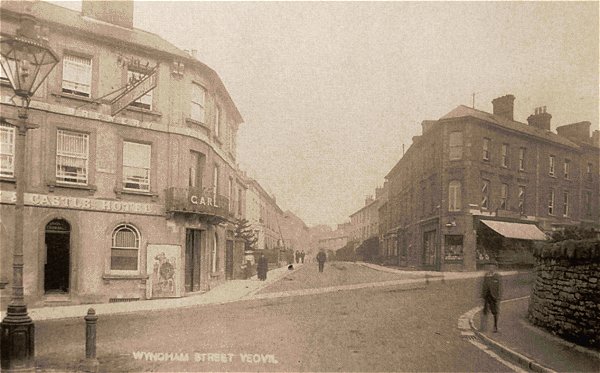
Wyndham Street photographed in 1905 with the Elephant and Castle Hotel at left and, at right the building of Clements & Sons Grocers & Wine Merchants building on this corner is now gone. Where the boy stands at lower right is the site where the Western Gazette office would be built in 1906. Note also at extreme left the three-light Sugg lamp.
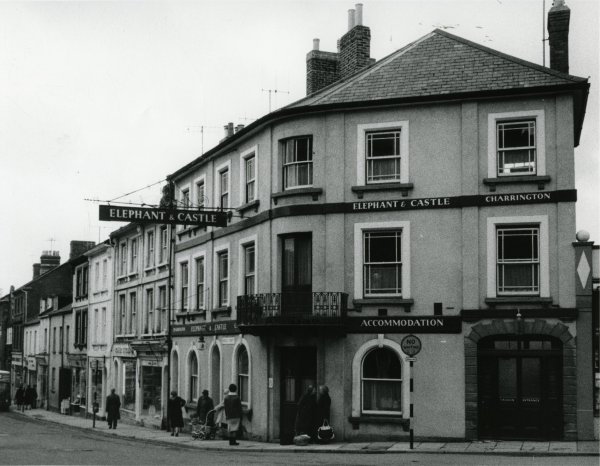
The Elephant & Castle photographed in the 1960s. Notice the glazed double doors at the bottom left, with 'Saloon Entrance' painted across the middle.
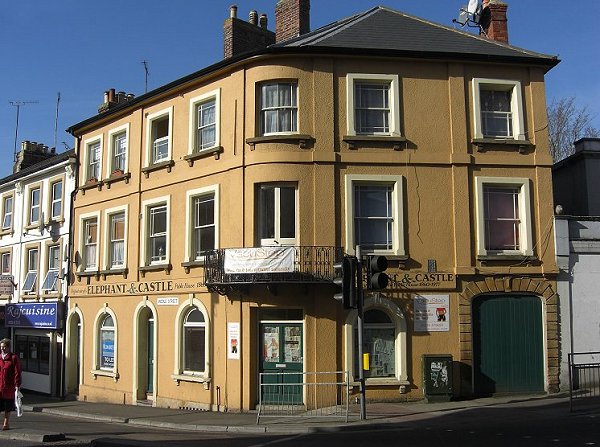
Photographed in 2012, the Elephant and Castle Hotel building has had a recent, and much needed, facelift - shame about all the tacky posters etc. in the windows and the equally tacky signage.
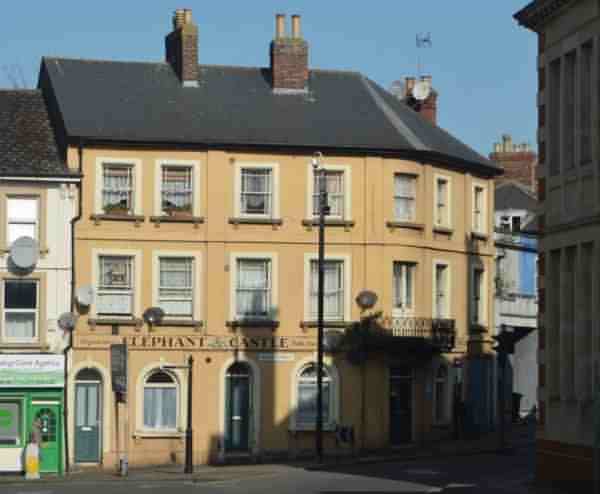
The Elephant & Castle photographed from Newton Road in 2017.
licensees
1859 –
Charles Blake -
applied for
spirit license (Petty
Sessions)
1861 – Job
Osment – Inn
Keeper (1861
census) listed
as Elephant and
Castle Inn
1861 – Job
Osment (Kelly's
1861 Directory -
Inns & Hotels)
1862 – Job
Osment -
committed
suicide (see
text above)
1861 – E Vincent
- owner -
objected to
license for
South Western
Arms (Petty
Sessions)
1864 – Thomas
Read – Landlord
- Witness in
court (Borough
Police Court,
march)
1871 – George
Snelgrove – Inn
Keeper (1871
census)
1875 – George
Snelgrove
(Kelly's 1875
Directory -
Hotels & Inns)
1878 – George
Snelgrove
(Whitby's Yeovil
Almanack
Advertiser 1878)
1881 – George
Snelgrove –
Licensed
Victualler (1881
census) listed
as Elephant and
Castle
1881 – George
Snelgrove
(Whitby's 1881
Yeovil Almanack
Advertiser)
1883 – James J
Williams
(Whitby's 1883
Yeovil Almanack
Advertiser)
Elephant and
Castle Hotel
1884 – James J
Williams
(Whitby's 1884
Yeovil Almanack
Advertiser)
1889 – James
Williams
(Kelly’s 1889
Directory)
listed as
Elephant &
Castle
1891 – David
Williams – Inn
Keeper (1891
census) listed
as Elephant and
Castle
1895 – David
Williams
(Kelly’s 1895
Directory)
listed as
Elephant &
Castle PH
1896 – Mrs D
Williams –
Proprietress
(Whitby's Yeovil
Almanack
Advertiser 1896)
1897 – Elijah
Trask (Kelly’s
1897 Directory)
listed as
Elephant &
Castle
1901 – Harriett
Frack – Hotel
Proprietress
(1901 census)
pub not named
1905 – William
Garlick (dated
photo above)
1911 – William
Garlick - Hotel
Proprietor (1911
census)
1914 – William
Garlick (Kelly’s
1914 Directory)
listed as
Elephant &
Castle Hotel
1923 – William
Garlick (Kelly’s
1923 Directory)
listed as
Elephant &
Castle Hotel
1936 – L Chant
(1936 Yeovil
Directory)
listed as
Elephant &
Castle
1938 – L Chant
(1938 Yeovil
Directory)
listed as
Elephant &
Castle
1939 – Ernest
Turvey (Kelly’s
1939 Directory)
listed as
Elephant and
Castle Hotel
1947 – EF Turvey
(1947 Yeovil
Directory)
listed as
Elephant &
Castle
1949 – EF Turvey
(Kelly’s 1949
Directory)
listed as
Elephant &
Castle
1951 – EF Turvey
(1951 Yeovil
Directory)
listed as
Elephant &
Castle
1954 – EF Turvey
(1954 Yeovil
Directory)
listed as
Elephant &
Castle
1957 – BA Cundy
(1957 Yeovil
Directory)
listed as
Elephant &
Castle
1960 – BA Cundy
(1960 Yeovil
Directory)
listed as
Elephant &
Castle
1965 – Licensee
not named (1965
Yeovil
Directory)
listed as
Elephant &
Castle
1968 – Licensee
not named
(Kelly’s 1968
Directory)
listed as
Elephant &
Castle
1969 – Licensee
not named
(Kelly’s 1969
Directory)
listed as
Elephant &
Castle
1970 – Licensee
not named
(Kelly’s 1970
Directory)
listed as
Elephant &
Castle
1971 – Licensee
not named
(Kelly’s 1971
Directory)
listed as
Elephant &
Castle
1972 – Licensee
not named
(Kelly’s 1972
Directory)
listed as
Elephant &
Castle
1973 – Licensee
not named
(Kelly’s 1973
Directory)
listed as
Elephant &
Castle
1974 – Licensee
not named (1974
Yeovil
Directory)
listed as
Elephant &
Castle